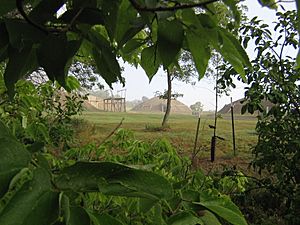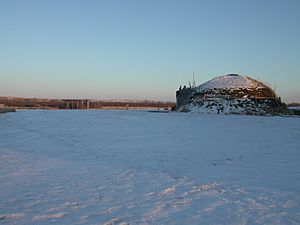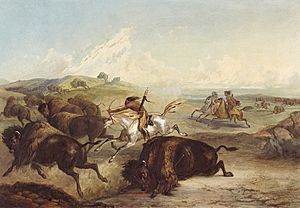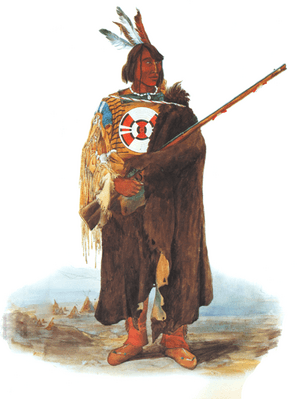Great Plains Indian Trading Networks before Lewis and Clark facts for kids
The Great Plains Indian Trading Networks were like ancient highways of trade. Native American groups on the Great Plains used these networks to exchange goods over huge distances. Important trading hubs were found in villages of the Mandan, Hidatsa, and Arikara peoples. These groups grew extra food, which they could trade. Other key centers included villages of the Pawnee, Kansa, and Osage in the central plains, and the Caddo villages in the south. The Dakota rendezvous was a big yearly trading event for the Sioux.
When Europeans arrived, their demand for animal furs changed everything. This led to more wars and forced some Native American nations to move. On the northern plains, the Hudson's Bay Company controlled much of the European trade. In the central plains, French traders from New Orleans and later St. Louis were in charge. By the mid-1700s, the Comanche became very powerful in the southern plains. They pushed the Apaches into the mountains and traded with groups in New Mexico.
Contents
How Did Trade Work on the Plains?
The trading networks on the Great Plains were like a complex system of connected markets. They allowed people to exchange goods over very long distances. The main trading centers were in villages of groups who lived in one place and grew lots of food. These villages had extra crops to trade.
Valuable items like shells from the ocean, shiny obsidian rock, and blue turquoise were traded. These items traveled thousands of miles from where they were found.
Main Trading Hubs
The most important trading centers were along the middle Missouri River. These were the villages of the Mandan, Hidatsa, and Arikara peoples. Their location was perfect for trade. They also grew lots of food and made many crafts.
Many different groups visited these villages to trade. These included the Cree, Assiniboine, Crow, Cheyenne, Arapaho, Kiowa, Plains Apache, and Comanche. The Arikara villages were also visited by the Sioux.
Other Important Trade Spots
South of the Arikara, the Sioux held the Dakota Rendezvous. This was a big yearly fair where they traded goods from other Native American nations.
On the central plains, the villages of the Pawnee, Kansa, and Osage were also important. In the southern plains, the Caddo villages were key centers. They connected the Plains trade networks with those in the Southwest.
Who Were the Middlemen?
Some groups acted as important middlemen, helping goods move between different areas.
- The Assiniboine and Cree connected the Mandan, Hidatsa, and Arikara centers with the Northern Plains. They also linked them to forest peoples north of Lake Superior.
- The Sioux brought goods from the Dakota Rendezvous to the Arikara.
- The Kansa helped trade between the Osage and the Pawnee.
- The Cheyenne traded between the Comanches, Plains Apaches, and the main centers on the Middle Missouri. This linked them to the Shoshone Rendezvous and trade networks in the Great Basin.
- The Comanche became a very important trading group in the southern plains after they arrived.
How European Trade Changed Things
When Europeans wanted furs, it changed the way Native Americans on the Great Plains lived. Their economy shifted from just providing for themselves to being influenced by markets. This led to more fights and wars between different Native American nations. Everyone wanted to control natural resources and trade routes.
New Tools and Animals
The horse became a huge game-changer. It replaced the dog for carrying things. Horses made hunting bison much easier and were valuable in war. Horses arrived on the Great Plains after the Pueblo Revolt in 1680. Thousands of horses spread north, reaching the Mandan, Hidatsa, and Arikara villages through the Shoshone Rendezvous. They also reached the Dakota Rendezvous and then spread to the farthest parts of the trade networks.
The musket (a type of gun) also spread through the Mandan, Hidatsa, and Arikara villages. Owning muskets gave groups a big advantage in war. This power helped them control resources and trade routes. During the 1700s, groups with guns pushed out groups without them. This completely changed who lived where on the Great Plains. Horses spread from south to north, and guns spread from north to south. It wasn't until 1850 that horses and guns were common in the same places.
Trade in the Northern Great Plains
Even though most of the northern plains belonged to French and later Spanish Louisiana, their traders didn't do much business there. Instead, the Hudson's Bay Company (HBC) from England controlled trade in this area. English muskets were highly desired. They changed the power balance between Native American nations.
In the 1700s, the Shoshone, who rode horses, controlled the northern Great Plains. But the Blackfoot, Gros Ventre, and Sarcee got HBC guns through Assiniboine middlemen. These groups then forced the Shoshone back into the mountains. The Mandan, Hidatsa, and Arikara traded directly with the HBC, mainly at Brandon House, which was built in the late 1700s. The HBC's main rivals were not from Louisiana, but from the North West Company based in Montreal.
By the late 1600s, the Cree and Assiniboine became middlemen for the HBC. They traded with more distant Native American nations. They kept their strong position with the help of English muskets. These two nations formed a close alliance in war and trade. They were also united by their dislike of both the French and the Sioux. During the 1700s, the Sioux were slowly pushed westward by the Cree and the Ojibwe. These groups had access to firearms. The Sioux moved onto the plains, changing their way of life from forest dwellers to plains people. At the same time, they pushed the Cheyenne further west.
Trade in the Central Great Plains
France controlled the trade of European goods in the central plains. The French were good at keeping friendly relations with Native American nations. They respected local customs and didn't try to replace existing traders. They gave generous gifts of guns and other goods to Native American leaders and their families. This helped their trade deals go smoothly.
The first French contact with central plains nations was in the late 1600s. But their trade really took off after New Orleans was founded in 1718.
Spanish Influence Declines
Increased French activity in the central plains worried the Spanish governor of New Mexico. He sent the Villasur expedition in 1720. But the Pawnee attacked and destroyed this expedition. This marked the end of Spanish influence in that area.
Bourgmont founded Fort Orleans in 1724. The Pawnee and Osage became the most important allies and trading partners for the French. The French relied on them to achieve their trade goals. However, these Native American groups did not let the French trade directly with nations further west.
After the French and Indian War, France gave Canada to the United Kingdom and Louisiana to Spain. But French traders from St. Louis, who were now Spanish subjects, continued to control trade with the central plains peoples. The main goal of the Spanish was to keep control of the area. They wanted to stop British and Canadian traders from entering. They used the same successful diplomatic methods as the French.
Trade in the Southern Great Plains

The trading networks in the Southwest were not harmed when Spain took over New Mexico in 1582. Spanish road building improved transportation. Major trading centers like the Zuñi Pueblo and the Pecos Pueblo came under Spanish protection. The Spanish needed furs, which they got from the southern plains. In return, they traded European goods that spread widely. However, these goods didn't cause major changes in the Native American cultures. The Spanish accepted that European and Native American ways of life could exist side-by-side.
The Rise of the Comanche
After the Pueblo Revolt, the Southwestern trading networks became even more important for the Spanish because of Comanche trade. By the 1720s, trading with the Comanche was a key part of New Mexico's economy. In the mid-1700s, the French started giving muskets to the Comanche. This allowed the Comanche to force the Apache off the plains and closer to the Pueblo and Spanish settlements.
The Spanish then changed their policy on firearms. They started selling guns and ammunition to the Comanche. They wanted to be friends with the Comanche and make them rely on a technology they couldn't make themselves. De Anza's treaty with the Comanche in 1786 brought peace to New Mexico. However, the Comanche continued to raid Texas and Coahuila. They brought their stolen goods north into the Southwestern trading system.
The Comanche visited the Southwestern trading centers. But they also used the Comancheros as middlemen to trade with the Spanish and the Pueblos. The peace also helped the Ciboleros. These were New Mexico bison hunters who brought hides and meat into the trading system.








